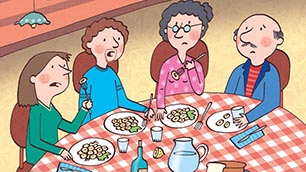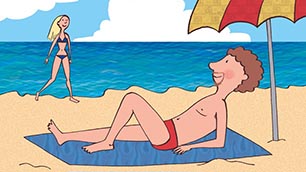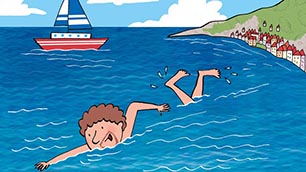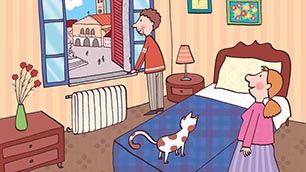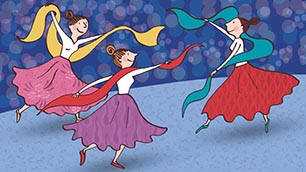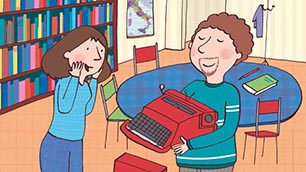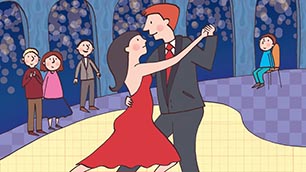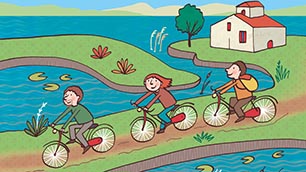| Silvia: | Oggi we will talk about the articoli indeterminativi. As you know, the articoli indeterminativi in inglese are “a” or “an”. |
| Connor: | Sì, a lezione di grammatica italiana. |
| Silvia: | Una lezione di grammatica italiana. The articoli indeterminativi precede singular nouns and have three forms in italiano. To choose the correct form of the articolo indeterminativo you’ll have to look at the genere of the noun that the article precedes, which can be (maschile o femminile). You will also need to consider the initial letter of the parola in question. |
| Connor: | Tre forme... genere... Initial letter... |
| Silvia: | Prima di una consonante, if the noun è maschile, you will use un, if the noun è femminile, you will use una. Would you like to try? |
| Connor: | Un giorno. Una donna. |
| Silvia: | Molto bene. My turn. Un treno e un biglietto. Una bicicletta e una ruota. |
| Connor: | This will be very helpful in Italia... |
| Silvia: | The treno o the bicicletta? |
| Connor: | Both... that’s another dream of mine... |
| Silvia: | Un sogno... A dream... |
| Connor: | Un sogno bello! Un sogno bellissimo! |
| Silvia: | Quale? |
| Connor: | I want to travel around Italia and see the places of La Dolce Vita... |
| Silvia: | Viaggiare in Italia nowadays è diverso from what it was like in the anni Cinquanta. |
| Connor: | But è un sogno! |
| Silvia: | Well, let’s try to get back to realtà and continue to talk about the articoli indeterminativi. What do you say? |
| Connor: | Una realtà of grammatica! |
| Silvia: | Bravo! If una parola begins with an “s” plus consonant, with the lettera “z” or the lettere “ps”, you will use uno when the noun è maschile e una when the noun è femminile. |
| Connor: | Una storia lunga e uno psicologo... like the one nonna Carmela will have to see. |
| Silvia: | Well, this è una frase molto bella, Connor! … E let’s hope nonna Carmela won’t have to see uno psicologo! |
| Connor: | Una amica di nonna Carmela says... |
| Silvia: | Ah! Sorry to stop you there... |
| Connor: | Did I say something wrong? |
| Silvia: | ...You said something that brings us back to our grammar topic. When a noun è femminile e begins with una vowel you will use un’. You drop the “a” di una and add the apostrofo. Like un’isola. |
| Connor: | So, una amica becomes un’amica? |
| Silvia: | Esatto. Un altro esempio could be... un’ambasciata italiana in America. |
| Connor: | Un’americana a Roma! Well, that was the film Un Americano a Roma... I just got a bit creative! |
| Silvia: | I like that! Creativity è molto useful for these esercizi. The article uno in italiano is also used to refer to the numero one, and follows the same rules as the articolo indeterminativo. |
| Connor: | I would like uno shot of espresso... |
| Silvia: | Here we go, bravo! ...I recently read that in Italia people drink in media tre espressi a day. |
| Connor: | Un espresso usually keeps me awake the whole day! |
| Silvia: | Well, the ideal numero è due al giorno. Quanti caffè americani do you drink al giorno, Connor? |
| Connor: | Usually due. |
| Silvia: | Each caffè americano is equivalent to due caffè espressi... so you basically drink quattro espressi al giorno! |
| Connor: | I didn’t know that... |
| Silvia: | Un caffè americano contains the same amount of caffeine as due espressi with the addition of some acqua. |
| Connor: | No wonder why at night I have trouble sleeping... |
| Silvia: | Quattro espressi al giorno sono molti! |







